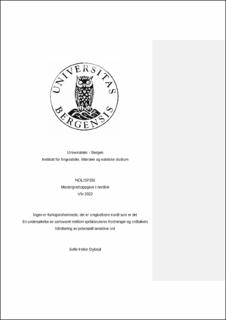| dc.contributor.author | Dybdal, Sofie Helen | |
| dc.date.accessioned | 2022-06-25T00:27:53Z | |
| dc.date.available | 2022-06-25T00:27:53Z | |
| dc.date.issued | 2022-05-20 | |
| dc.date.submitted | 2022-06-23T22:02:45Z | |
| dc.identifier.uri | https://hdl.handle.net/11250/3000826 | |
| dc.description.abstract | Sammendrag I mastergradsoppgaven har jeg, ved hjelp av en digital spørreundersøkelse, undersøkt 208 respondenters holdninger til og bruk av ni ord som betegner psykiske og fysiske funksjonsnedsettelser. Respondentene har oppgitt i hvilke sammenhenger de bruker de ulike ordene, samt karakterisert bokstavelig og overført bruk av ordene som enten nøytrale eller upassende/støtende. Resultatene fra spørreundersøkelsen har blitt sammenlignet med to ordbøkers definisjoner og bruksmarkeringer av de samme termene, Det Norske Akademis Ordbok (NAOB) og Bokmålsordboka (BOB). Ordene som har blitt presentert for respondentene har blitt delt inn i fysiske og psykiske funksjonsnedsettelser, der man i førstnevnte finner ordene handikappet, kortvokst, funksjonshemmet og invalid, og i sistnevnte finner man ordene mongoloid, schizofren, bipolar, autist og retardert. Problemstillingen min er som følger: I hvilken grad er det samsvar mellom språkbrukeres holdninger til og bruk av potensielt sensitive termer innenfor fysisk og psykisk funksjonsnedsettelse, og ordbøkers håndtering av disse termene? Forskningsspørsmålene som jeg svarer på i oppgaven er: I hvilke sammenhenger blir de aktuelle termene brukt? Hva slags holdninger har språkbrukerne til konkrete eksempler på bruk av termene? Er det noen forskjell på opplevd sensitivitet knyttet til grunnleggende og overførte betydninger? Hvilke definisjoner og bruksmarkeringer finner man oppført i BOB av ordene som undersøkes i oppgaven? Hvilke definisjoner og bruksmarkeringer finner man oppført i NAOB av ordene som undersøkes i oppgaven? Funnene fra spørreundersøkelsen viser blant annet at respondentene opplever visse ord som sensitive eller upassende, uavhengig av kontekst. Resultatene viser også stor forskjell på opplevelse av bokstavelig og overført bruk, spesielt i henhold til de psykiske diagnosene schizofreni, autisme og bipolar lidelse. Flere karakteriserer de psykiske diagnosene i overført bruk som upassende/støtende, enn den bokstavelige bruken. I henhold til ordbøkene er det i denne oppgaven funnet mest samsvar mellom undersøkelsens resultater og NAOB sine definisjoner og bruksmarkeringer. NAOB har satt opp langt flere betydninger av de ulike termene som undersøkes, enn det BOB har. Det er tydelig at ordbøkene gjør noe i arbeidet med potensielt sensitive ord, men i visse tilfeller gjør de ikke nok. | |
| dc.description.abstract | Abstract In have in this masters degree researched 208 people’s associations of and usage of nine words which describes mental and psychical disabilities, with the help of a survey. In the survey the participants have answered questions about which settings they use these words. They have also given answers on how they’d characterize these words in a literal and in a figuratively matter, where they’d choose between two options: neutral or sensitive/improper. The results from the survey have been compared to two separate dictionary’s definitions and usage indications of the same words/terms, Det Norske Akademis Ordbok (NAOB) and Bokmålsordboka (BOB). The words that have been introduced to the participants in the survey was divided into physical and mental disabilities. Within psychical disabilities one will find the words handicapped, short-grown, function disability, invalid, and within mental disabilities one will find the words mongoloid, schizophrenia, bipolar disorder, autistic and retarded. The main question that I seek an answer to is the following: In which sense can one find consistency between language users associations and usage of potentially sensitive words within psychical and mental disabilities, and the dictionaries handling of the terms in question? The research questions that I answer in this assignment is: In which contexts are the actual terms used? What kind of attitudes does language users have towards concrete examples of the usage of the terms? Is there any difference between sensitivity in correlation to literal and figurative meanings? What kind of definitions and usage indications of the terms in question can one find in BOB? What kind of definitions and usage indications of the terms in question can one find in NAOB? The findings from the survey show that the participants experience certain words as sensitive, no matter what the circumstances are. The results also show a big difference in the experiences of the words used in a literal and figurative matter, especially with the mental disabilities schizophrenia, autistic and bipolar disorder. A big amount of the participants characterizes the mental disabilities as sensitive in a figuratively matter. In accordance with the dictionaries, there has been discovered most consistency between the survey’s participants and NAOB’s definitions and usage indications. NAOB has included far more meanings of the words that has been researched in this assignment than BOB has done. Clearly, the dictionaries are doing something in their work with potentially sensitive words, but not nearly enough. | |
| dc.language.iso | nob | |
| dc.publisher | The University of Bergen | |
| dc.rights | Copyright the Author. All rights reserved | |
| dc.title | Ingen er funksjonshemmede, det er omgivelsene rundt som er det | |
| dc.type | Master thesis | |
| dc.date.updated | 2022-06-23T22:02:45Z | |
| dc.rights.holder | Copyright the Author. All rights reserved | |
| dc.description.degree | Mastergradsoppgave i nordisk språk og litteratur | |
| dc.description.localcode | NOLISP350 | |
| dc.description.localcode | MAHF-NORD | |
| dc.description.localcode | MAHF-LÆNO | |
| dc.subject.nus | 711123 | |
| fs.subjectcode | NOLISP350 | |
| fs.unitcode | 11-21-0 | |
